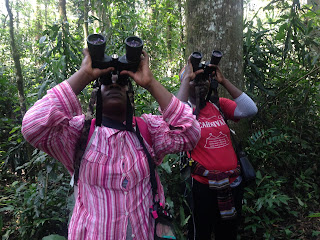 |
| Field Assistants Sheila and Sylvia in T-West North group |
My study is observational, not experimental. Observations and experiments go hand-in-hand, but are different: experimenters manipulate conditions and observers do not (e.g. day length in colony room vs. day length according to natural season). In both types of studies, the researcher measures one or more conditions (e.g. day length) and response variables of interest (e.g. song frequency of birds). You may sometimes hear of "natural experiments" - these are times when mama nature herself (aka God +/- chance) is the manipulator, creating different conditions across which researchers measure and compare a response. For example, to see the effect of military service on income, a researcher could compare the income of veterans vs. non-veterans, given a random draft. Most observational studies take advantage of these natural experimental conditions, and so do I. Take away: I observe the monkeys' behavior with little to no involvement in it.
In 1974, a smart woman named Jeanne Altmann did everyone in the emerging field of behavioral ecology a big favor - she wrote "Observational Study of Behavior: Sampling Methods." In doing so she succinctly described the various ways that people can (and perhaps should) sample spontaneously occurring behavior. One of these ways, now ubiquitously common, is called the "focal follow." And in the focal follow you can employ a variety of recording techniques…
 |
| Frisbee, Sheila, and our digital data sheets |
We try to do the same number of follows for each subject each month and conduct those follows evenly throughout the day…
 |
| Game-face time: the forest observers and monkeys traverse |
Nevertheless, there is that lovely 15% of the time when the monkeys come low, and the 5% when the follow is an absolute and glorious cakewalk. See above a photo of Sheila's cakewalk with Frisbee and a view of our tablet interface.
I'll save the fun details of how we collect hormone samples (pee and poop!) for another time.
I hope you've enjoyed a glimpse into the world of focal follows! For more details, please just ask ;).
Lots of love,
Nicole

Yep Thanks for saving that pee and poop business. I was eating while reading this...Haha! But correct me if I'm wrong, is bike the cool teenage furry friend of our? I remember you telling me about him. Anyways, great read! I learn some new words too Yay!! Miss you and I think you and what you do are so boss!
ReplyDeleteYou're the best, HO ;) thanks for reading. Yes, Bike is our teenage friend, he's a rebel but a total mama's boy, always hanging with his mama Bif ;). love you and talk to you SOON!! oxoxo :)
Delete